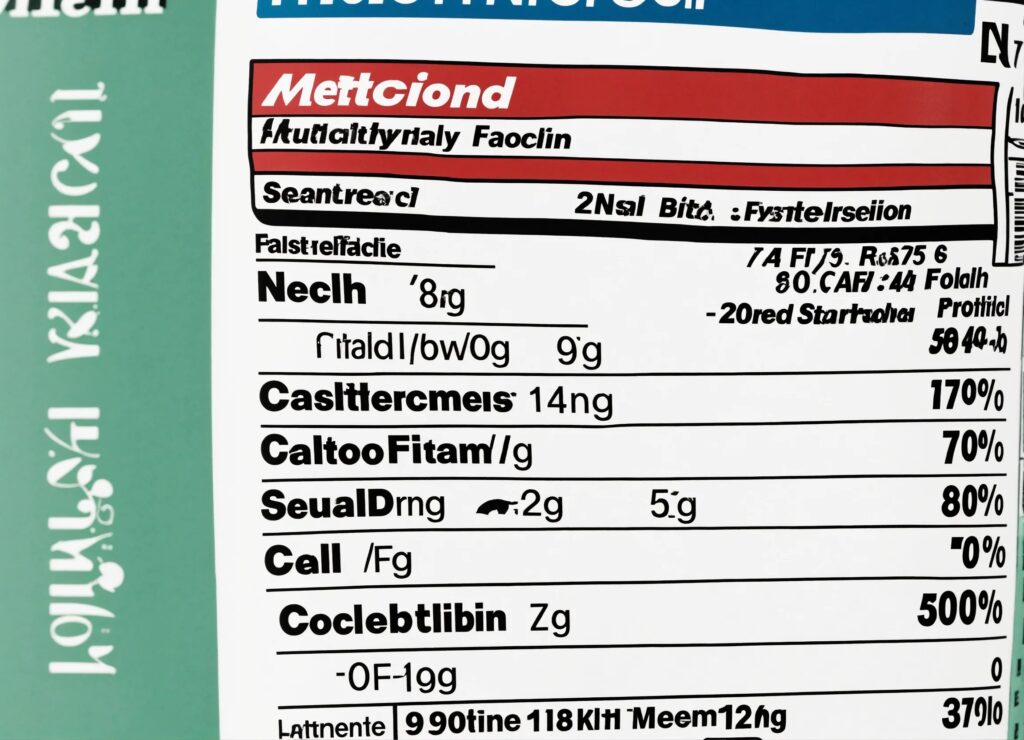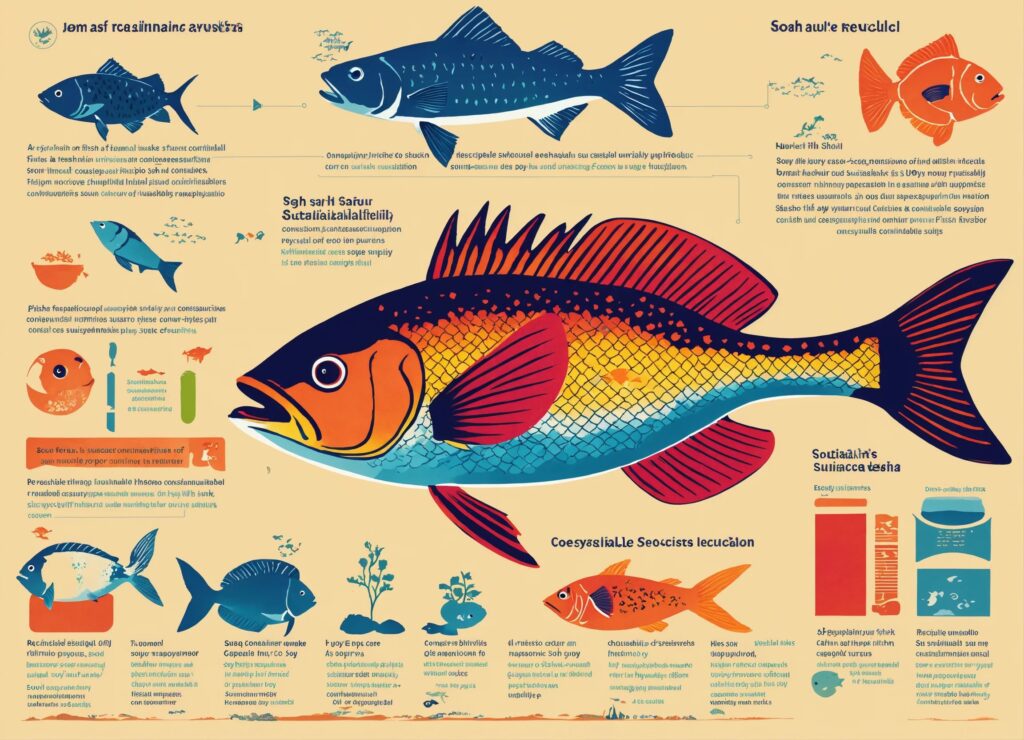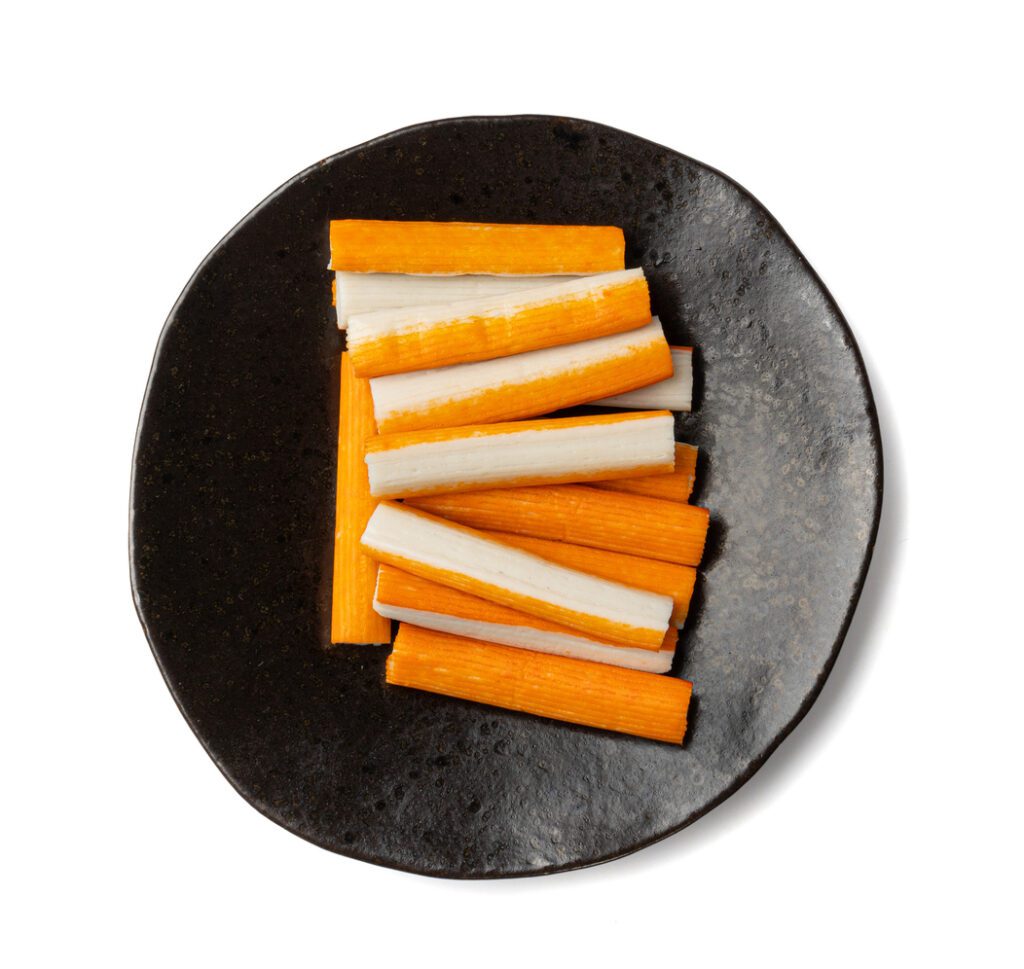The culinary world loves imitation crab meat for its versatility and intrigue. It shines in sushi rolls and adds flair to pasta and salads. This cost-effective alternative to crab meat fuels creativity in kitchens globally. But what is it, and how should we best enjoy it? We’re on a mission to find out. Our article will navigate the best ways to savor imitation crab meat. We’ll cover its origins, nutritional value, and dive into recipes and tips. So, let’s start this flavorful journey.
Introduction
Imitation crab , made from finely ground white fish like pollock, mimics real crab’s taste and texture. Originating in Japan, this culinary invention has gained worldwide popularity. It’s not just affordable and convenient but also versatile. It has proven its value from Tokyo’s sushi bars to California’s salad bars. This journey into imitation crab will reveal production secrets, preparation best practices, and the tastiest ways to enjoy it. Whether you’re a chef or a foodie, you’re in for a treat. Let’s discover the best ways to enjoy this seafood favorite.
Understanding Imitation Crab Meat
What is Imitation Crab Meat?
Diving into the world of imitation crab , we uncover a product known for its versatility and affordability. At its core, imitation crab meat, or surimi, is a fish-based product designed to mimic the taste and texture of real crab meat. The primary ingredient is white fish, commonly pollock, which undergoes a transformation process. This process involves cleaning, mincing, and then blending the fish with ingredients like starch, egg whites, and crab flavoring to achieve the desired consistency and taste. This culinary innovation, originating from Japan, has made its way into kitchens worldwide, offering a seafood experience that’s both accessible and delicious.
Benefits and Drawbacks
The allure of imitation crab meat lies in its numerous benefits. It stands out as a cost-effective alternative to real crab, offering a similar taste experience without the hefty price tag. Its versatility is another plus, easily incorporated into a wide range of dishes from salads and sushi to comforting casseroles. Moreover, its wide availability makes it a convenient option for many.
However, it’s essential to weigh these advantages against certain drawbacks. Nutritionally, imitation crab may fall short compared to its real counterpart, particularly in protein content and omega-3 fatty acids. It’s also worth noting that some brands may include additives and preservatives, which could be a concern for those mindful of their dietary intake.
By understanding both the positives and the limitations of imitation crab , consumers can make informed choices that align with their culinary preferences and health considerations. This balanced view paves the way for exploring the best methods to enjoy imitation crab meat, ensuring each dish is both delightful and satisfying.
For a deeper understanding of how seafood, like imitation crab meat, contributes to a healthy diet, the Washington State Department of Health outlines the Health Benefits of Fish, emphasizing the importance of omega-3 fatty acids and vitamins.
Best Ways to Enjoy Imitation Crab
As Part of Seafood Dishes
Imitation crab meat shines brightest when it’s part of a larger ensemble of flavors, especially in seafood dishes. Its mild taste and versatile texture make it an excellent addition to sushi rolls, where it complements the delicate flavors of rice, seaweed, and vegetables. Another popular option is to toss it into seafood salads, where it can add a crab-like essence without overwhelming the other ingredients. These dishes benefit from the unique properties of imitation crab meat, offering a seafood experience that’s both satisfying and accessible.
In Cooked Recipes
Cooked recipes present another fantastic opportunity to showcase imitation crab meat. Stir-fries and pasta dishes are particularly well-suited to this ingredient. In stir-fries, imitation crab meat can absorb the rich flavors of sauces and spices, while in pasta dishes, it adds a luxurious seafood element without the cost associated with real crab. Baked and broiled recipes, such as casseroles, are also excellent choices. Here, imitation crab meat can meld with other ingredients, creating comforting dishes perfect for family dinners or special occasions.
Creative Serving Ideas
For those looking to get creative in the kitchen, imitation crab meat offers endless possibilities. It can be the star of appetizers and snacks, such as in crab dip or formed into crab cake-style patties. These options are perfect for parties or as a treat to enjoy any time. Another innovative approach is to incorporate imitation crab meat into traditional dishes from various cuisines, offering a new twist on classic recipes. Whether it’s adding it to a Creole gumbo or mixing it into a Mediterranean-style pasta, imitation crab meat adapts beautifully to a range of culinary styles.
Exploring these diverse ways to enjoy imitation crab meat not only expands your culinary repertoire but also allows you to savor the flavors of the sea in a budget-friendly, convenient manner. Each method, from simple salads to elaborate cooked dishes, highlights the ingredient’s versatility and appeal, inviting both novice cooks and seasoned chefs to experiment and discover their favorite ways to use imitation crab meat.
Cooking Tips and Techniques
Preparing Imitation Crab
Proper preparation of imitation crab meat sets the stage for delicious dishes. If it’s frozen, thaw it in the fridge overnight or quickly in cold water. Once thawed, gently pull the pieces apart. A quick marinade in olive oil, lemon juice, and herbs can add flavor before cooking.
Cooking Methods
Since imitation crab meat is precooked, it only needs warming. Add it last in hot dishes to avoid toughness. For stir-fries or pasta, a quick sauté works well. In salads or cold dishes, use it directly without further cooking. Steaming or light pan-frying are best to keep it moist and flavorful. High heat or long cooking can harm its texture. These methods ensure your imitation crab enhances your dish without overpowering other ingredients.
For those eager to dive deeper into the culinary possibilities of imitation crab, our Imitation Crab Recipes & Cooking Tips article offers a treasure trove of inspiration and guidance.
Nutritional Profile and Dietary Considerations

Understanding the Nutritional Content
Imitation crab meat offers a different nutritional profile compared to real crab meat. It’s important to understand its components, such as lower protein and omega-3 fatty acids, and higher carbohydrate content due to added starches and sugars. This section could delve into the specifics of its nutritional value, helping readers make informed dietary choices.
Dietary Considerations
Discuss how imitation crab meat fits into various dietary needs, including its suitability for those with shellfish allergies, its place in weight management plans, and considerations for those with dietary restrictions related to processed foods.
While exploring the nutritional aspects of imitation crab, it’s also beneficial to understand the broader context of seafood’s impact on health. UnityPoint Health offers insightful dietitian advice on incorporating seafood into your diet for its health benefits, including lowering triglycerides and improving eye health. For those interested in how different types of seafood, including options like imitation crab meat, can contribute to a balanced diet, the article Fish to Eat for Health: Dietitian Advice is an excellent resource.
Sustainability and Ethical Considerations

The Environmental Impact
Explore the environmental implications of choosing imitation crab meat over real crab, including aspects of fisheries management, bycatch, and the sustainability of pollock fishing, which is the primary source of surimi.
Ethical Considerations
Consider the ethical dimensions of seafood consumption, including the welfare of marine life and the impact of fishing practices on ocean ecosystems. This section could offer insights into making ethical seafood choices, highlighting imitation crab meat as a potentially more sustainable option.
Creative Recipes and Serving Suggestions

Simple and Delicious Recipes
Provide readers with easy-to-follow recipes that showcase the versatility of imitation crab. From classic California rolls to innovative salads and comforting soups, these recipes could inspire readers to experiment with imitation crab meat in their cooking.
Serving Suggestions for Every Occasion
Offer ideas for incorporating imitation crab into meals for various occasions, whether it’s a quick weekday dinner, a special holiday meal, or entertaining guests. This section could include tips on presentation and pairing imitation crab meat with other ingredients for balanced and appealing dishes.
FAQs
Let’s delve into some frequently asked questions about imitation crab , offering detailed insights to enhance your culinary knowledge and experience.
Can you eat imitation crab meat straight from the package?
Absolutely! Since imitation crab is fully cooked during its manufacturing process, you can safely eat it straight from the package. It’s a convenient option for quick snacks, salads, or adding a seafood twist to your meals without additional cooking.
How do you make imitation crab meat taste better?
Enhancing the flavor of imitation crab meat is easy with a few simple tricks. Marinating it in a mixture of lemon juice, olive oil, and your favorite herbs can add depth and freshness. For cooked dishes, sautéing imitation crab with garlic, butter, and a splash of white wine can elevate its flavor significantly.
Is imitation crab suitable for people with shellfish allergies?
Generally, yes. Since imitation crab is made from fish (usually pollock) and not actual shellfish, it’s often suitable for people with shellfish allergies. However, it’s crucial to read the product labels carefully, as some brands may add shellfish flavoring or process the product in facilities that handle shellfish, posing a risk of cross-contamination.
How long does imitation crab last in the fridge?
Unopened, imitation crab can last in the fridge until the date printed on the package. Once opened, it’s best to consume it within 3 to 5 days. Ensure it’s stored properly in a tightly sealed container to maintain its freshness and prevent it from drying out.
Can imitation crab meat be frozen?
Yes, you can freeze imitation crab to extend its shelf life. Wrap it tightly in plastic wrap or place it in a freezer bag, removing as much air as possible. Properly stored, it can last for up to 6 months in the freezer. Thaw it in the refrigerator overnight before using it in your recipes.
These FAQs aim to address common concerns and curiosities about imitation crab , providing you with the knowledge to enjoy this versatile ingredient confidently and creatively in your culinary endeavors.
Embracing the Versatility of Imitation Crab Meat
As we’ve journeyed through the multifaceted world of imitation crab , from its origins and nutritional profile to cooking tips and creative recipes, one thing remains clear: this ingredient is a culinary chameleon, capable of elevating a wide array of dishes with its unique charm. Whether you’re enjoying it straight from the package in a quick salad or transforming it into a gourmet meal, imitation crab offers a blend of convenience, versatility, and flavor that’s hard to beat.
The journey doesn’t end here, though. With the knowledge you’ve gained about preparing, cooking, and serving imitation crab , along with understanding its nutritional considerations and environmental impact, you’re well-equipped to explore new culinary horizons. The FAQs section has hopefully clarified any lingering questions, empowering you to incorporate imitation crab into your cooking repertoire with confidence.
In embracing imitation crab , you’re not just choosing a budget-friendly seafood alternative; you’re also embracing a world of culinary creativity. It’s an invitation to experiment, to blend tradition with innovation, and to discover the joy of cooking with an ingredient that transcends its humble beginnings. So, go ahead, let your culinary imagination run wild, and let imitation crab be the star of your next culinary adventure.
The Nutrition Source from Harvard T.H. Chan School of Public Health provides a balanced view on the topic, discussing both the potential benefits and concerns of seafood consumption in their article, Fish: Friend or Foe?.
Remember, great cooking isn’t just about following recipes to the letter; it’s about adapting, experimenting, and finding joy in the process. With imitation crab the possibilities are as vast as the ocean itself. Here’s to your next delicious discovery!
Conclusion: The Culinary Journey with Imitation Crab Meat
Exploring imitation crab reveals its culinary versatility and appeal. This journey has shown us its origins, nutritional aspects, and how it fits into various dishes. Whether used straight from the package or as part of elaborate recipes, imitation crab meat stands out for its convenience and taste.
The Essence of Imitation Crab Meat
At its core, imitation crab is about simplicity and innovation. Originating from Japan, this seafood alternative has crossed global culinary boundaries. It’s not just an affordable option but a testament to culinary creativity. Its preparation and cooking techniques, shared earlier, highlight its adaptability. From quick salads to gourmet dishes, imitation crab can do it all.
Nutritional and Environmental Insights
Nutritionally, imitation crab offers a lower-protein alternative to real crab, suitable for certain diets but with considerations for its additives. Environmentally, it presents a more sustainable choice, reducing the demand on crab populations. These aspects encourage informed culinary choices, balancing taste with health and sustainability.
Culinary Creativity Unleashed
The recipes and serving suggestions provided illuminate imitation crab meat‘s potential to transform meals. It invites home cooks and chefs alike to experiment and innovate. The FAQs aimed to clear up common queries, empowering you with the knowledge to use imitation crab meat confidently.
Embracing Imitation Crab Meat
In conclusion, imitation crab meat is more than a seafood substitute. It’s a bridge to culinary exploration, blending tradition with innovation. This guide has equipped you to navigate its uses, from nutritional considerations to creative recipes. It’s an invitation to discover cooking’s joy with an ingredient that transcends expectations.
Cooking is an adventure, a chance to experiment and enjoy the process. With imitation crab , the culinary possibilities are vast. Here’s to your next delicious creation with imitation crab . Happy cooking!

